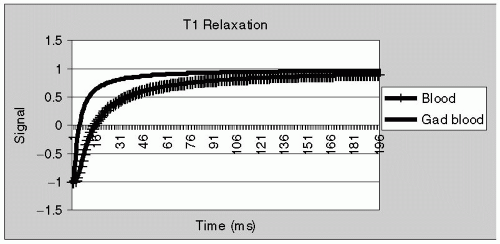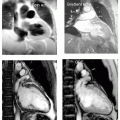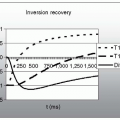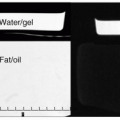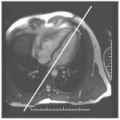Perfusion and Viability
Mark Doyle
OVERVIEW
Myocardial perfusion and viability imaging both involve imaging contrast conditions following administration of a bolus of contrast agent. There is little or no inherent signal characteristic of myocardium that differentiates normally perfused tissue from tissue at risk of ischemia. For this reason, an exogenous contrast agent is required. At rest, it is used to detect the presence or absence of resting ischemia, and under vasodilatation conditions it is used to detect high-grade coronary artery stenoses by provoking a transitory ischemia.
PARAMAGNETISM
Most contrast agents reduce the tissue T1 when they come in close contact with the tissue. Commonly, agents exhibit the property of paramagnetism, which results in a slight increase in the local magnetic field. Although water has a natural T1 relaxation time in the range of 700 to 1,000 milliseconds, the addition of paramagnetic impurities can dramatically reduce the T1 relaxation time (i.e., increase the relaxation rate). Gadolinium (Gad) is a paramagnetic agent that possesses unpaired electrons. These paramagnetic particles tumble and rotate at frequencies close to the Larmor frequency of protons, resulting in reducing the T1 of protons (see Fig. 29-1).
CONCENTRATION AND RELAXIVITY
where T1w/o is the T1 without Gad and R(Gad) is the concentration of Gad (see Fig. 29-2). The relaxivity of Gad is in the range 4 to 10 mm/sec/kg. Gad is a heavy metal, which is naturally toxic, but is rendered inactive by the process of chelating, effectively surrounding the Gad particle with a molecular cage. Gad is commonly chelated with diethylenetriaminepentaacetic acid (Gd-DTPA), which has a molecular weight of approximately 600, and a blood half-life of approximately 40 minutes.
REGION OF OPERATION
Gd-DTPA is an extracellular agent and is not confined to the blood pool. It is not taken up by cells and is excreted by the kidneys and liver. In most cases, the administration of Gad occurs without adverse incident; however, there are some side effects to be aware of:
Headache <10%
Coldness at injection site <5%
Severe reaction <1%
To confine Gad to the blood pool, it has to be bound to a larger agent such as albumin, with a molecular weight of 70,000 to 100,000. The clearance time for this formulation is several weeks, and due to the long residency time, there are concerns with toxicity.
NANOPARTICLES
Nanoparticles are increasingly being used to deliver Gad contrast agents. A common nanoparticles delivery agent is 19-Fluorine, which forms the core of the particle (see Fig. 29-3). The core is surrounded by a lipid membrane to which are attached upward of 100,000 Gad particles. The diameter of the particle is on the order of 250 nm and has a relaxivity value in excess of 20,000. Nanoparticles can be designed to target specific sites, and be activated by a number of mechanisms, including the following:
Functional activated agents
Enzyme activated agents
Reporter agents
Stay updated, free articles. Join our Telegram channel

Full access? Get Clinical Tree


